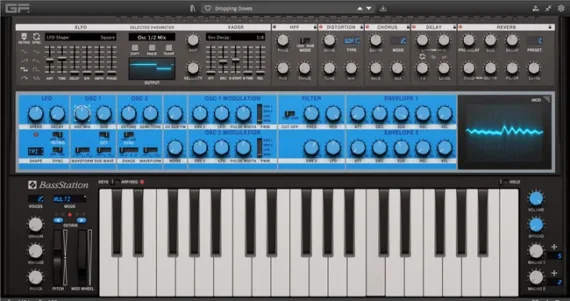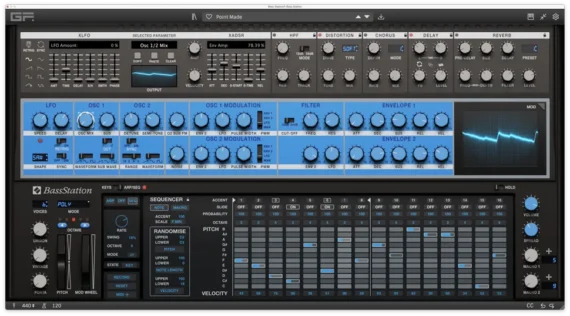GForce + Novation Intro Bass Station Virtual Instrument

GForce Software, in collaboration with Novation, has introduced GForce Bass Station, a plugin-in version of the original Bass Station hardware synthesizer from 1993.
Beloved by many of electronic music’s most significant figures -like Aphex Twin, who was heavily involved in the launch of the Bass Station II back in 2013 and the instrument that arguably remains the spiritual flagship of Novation, the Bass Station has been a cornerstone of heavy-hitting low-end since its launch way back in 1993.
Now, a collaboration between the Bass Station’s designers and soft synth polymath GForce Software has resulted in the definitive – and official – software version.
Though at heart an exacting emulation of the original hardware, the new software architecture allows this Bass Station to go well beyond many of the limitations of the original synth. And its feature set has been expanded quite significantly.
Perhaps the biggest talking points here are its broader 16-voice polyphony and unison mode (as well as a ‘combined’ setting). Using these in tandem, this software Bass Station will enable users to generate bigger, fatter and layered sounds of the sort that the original wasn’t capable of.

Further new additions include a massively enhanced signal path, including new waveforms, an extra sub-oscillator (if things weren’t quite bassy enough…), wider LFO possibilities, a more dynamic high-pass filter and filter key tracking. All of this does much to widen the Bass Station’s scope.
Another major feature is the Bass Station’s in-built arpeggiator and sequencer. This will enable users to program their own patterns and loops at will, with controls for step length, velocity, swing, probability, scales and an enticing randomisation feature.
By collaborating with GForce Software on this, Novation’s beefy bad boy can now harness the wider flexibility of the soft synth maker’s’X-Modifier technology. This modulation expander basically allows users to create detailed modulations on pretty much any parameter available.
If that weren’t enough to satiate your low-end creative hunger pangs, there’s also a big stack of effects to daube onto those bass sounds, or to use more subtly. Effects like distortion, chorus, delay and reverb can do much to colour low-end, and we’re looking forward to working with this new palette.
Here’s what they have to say about it:
“The original Novation Bass Station, launched in 1993, is celebrated for its raw, punchy, and unmistakably analogue character. Designed during a period when digital synthesisers dominated, the Bass Station brought analogue warmth and grit back into the spotlight, making it a cult favourite among producers.
The Novation Bass Station by GForce, whilst remaining sonically faithful to the original, has been extensively enhanced, now offering polyphony, unison modes, a powerful modern sequencer, and expansive modulation capabilities with the advanced X-LFO and X-ADSR. These updates bring unprecedented depth and flexibility to the Bass Station’s iconic sound.
And if you are a registered customer of the Novation Launchkey MK4, FLKey, or SL MK3, Novation and GForce are delighted to offer you this plugin for free. Simply log in to your Novation account for more information!”
GForce Bass Station intro video:
If this sounds a little bit much to get your head around, then thankfully, 300 presets come fully-loaded, giving users perfect starting points across a range of styles and sonic characters.
All in all, this software Bass Station sounds pretty special, then. Especially for those of us who work solely in the box but yearn for some of those authentic, bone-shaking bass sounds of yesteryear.
Features:
- An emulation of the 1993 original Novation Bass Station
- Developed in collaboration with Novation
- Mono, Mono Unison, Legato, Autoglide and Poly Modes, up to 16 voices
- Augmented with vast modulation options via X-Modifiers
- Arpeggiator and Sequencer including macro automation
- Unique 2-pole or 4-pole filter with screeching resonance
- Fully-scalable UI
- Over 300 presets
- Powerful Preset Browser
- Pan Spread
- High-Pass Filter, Distortion, Chorus, Delay and Reverb effects
- Two programmable Macros for easy manipulation of sounds
- Programmable Velocity Responses and Poly Aftertouch
GForce Bass Station is available now with an intro price of £49.99 + VAT through the end of February (normally £99.99 + VAT). It will also be available to all Novation Launchkey 4, FLkey, and SL Mk3 customers upon registration.




